Long before I moved to Back of the Yards, I was familiar with the neighborhood’s history as Chicago’s meatpacking district. In high school, I was introduced to Carl Sandburg’s poetry, in which the neighborhood earned Chicago the title of “hog butcher for the world.” I read Upton Sinclair’s The Jungle, the iconic and gruesome novel about a Lithuanian immigrant’s struggles as a packinghouse worker at the turn of the twentieth century. This is the lens through which most outsiders view the neighborhood: an apex of class struggle and humiliation. A community dwarfed by the stench of factories, stockyards, and slaughterhouses. And in a more contemporary sense, a neighborhood rife with gang violence.
The name “Back of the Yards” refers to the community area including and surrounding what was once the Union Stockyards—and is today known as the “Stockyards Industrial Park”—but it’s important to note that the neighborhood is larger than that. Back of the Yards goes from Halsted to Western and from Pershing to Garfield. In the early 1900s, the neighborhood was primarily populated by immigrants of various European backgrounds who came to work at the stockyards. The neighborhood underwent a number of demographic changes starting in the 1950s: African Americans from the South arrived in Chicago, as part of the Great Migration, and Mexican immigrants started settling in the neighborhood as the descendants of the earlier European immigrants started moving out to the suburbs.

The first time I visited the neighborhood, it was 2009 and I was filming a documentary about its history. I approached this visit with the aforementioned mindset, but was quickly introduced to a much broader sense of what the community is all about, and what is so frequently missing in the outside narrative of struggle—the response, the organizing, and the ceaseless determination.
Several years ago, I interviewed Les Orear, a former packinghouse worker and a founder of the Illinois Labor History Society. He told me that, despite the segregation in the neighborhood, individuals from every single ethnic and racial background could be found at union hall meetings. Thirty years prior to this country’s Civil Rights Movement, workers of all races could be seen going on strike together, marching together and holding signs that read “Black and White: Unite & Fight!” At a time of racial tension and riots, Back of the Yards set a precedent for unity in the face of greater adversity.
The neighborhood today can be summarized as a small world in a big city. Everyone knows someone who knows someone else. Everyone knows the boundaries, too: both the physical ones—the streets, the viaducts—and the ones that are imagined, but nonetheless real. Which turf belongs to which gang. Which portion of the neighborhood is predominantly Mexican, and which is predominantly African American. But just as they were in the neighborhood’s past, the continued struggles of today’s Back of the Yards are marked by activism and collective organizing by numerous residents and organizations. These stories don’t always make the news, but they’re important to mention because they’re a continuation of efforts that have had an impact on the city and the country. The volunteers who coach kids’ soccer teams to keep them out of trouble in the summertime, the traditional dance group that won several national championships while promoting Mexican culture, the entrepreneur who rehabbed a previously vacant warehouse and now uses it as an indoor farm for the community—these efforts might be part of an uphill battle, but they have meaning.
For decades, Back of the Yards has been a launching pad for incoming migrants and immigrants. Even my own family is emblematic of this: I’m a transplant from Wisconsin, and my husband is a Mexican immigrant. For us, it’s important that we not only consider the history of our neighborhood, but we honor it by continuing the tradition of standing up to adversity and connecting with others around us. We never lose faith. The fight must continue.
Naomi Ezquivel has been a homeowner and resident of Back of the Yards since 2014. She currently works in the public safety field and is passionate about social issues, especially immigration reform, public education, and mental health.
Best Scents
Perfumes Europeos

For the past fourteen years, the smell of perfume has drifted through the corridors of Swap-O-Rama on Ashland Ave. If you get lost in the labyrinth of makeup supplies, kitchen appliances, barbershops, and produce, let it guide you back to one of the two stalls that Perfumes Europeos occupies inside the market. The setup is simple: a glass counter displaying the various container sizes and a backdrop of the hundreds of scented oils from which owner Elvia Arena and her colleague, Edith Sanchez, conjure the fragrances. While they specialize in replicating branded scents (think designer perfumes but for a fourth of the price), customizing scents by mixing pre-existing ones is also common, and something customers often request. (“They get creative,” says Sanchez.) While it costs $1 ($2 on weekends) to enter the Swap-O-Rama space, Arenas’ olfactory expertise and the other random finds you’ll come across (herbs galore, $2 makeup brushes, and all the Mexican candy you can imagine) make a visit more than worth it. (Isabelle Lim)
Perfumes Europeos in Swap-O-Rama Flea Market, 4200 S. Ashland Ave. Tuesday, 7am–2pm; Thursday, 7am–3pm; Saturday–Sunday, 7am–4pm. $1 Tuesday and Thursday; $2 weekends. (708) 344-7300. swap-o-rama.com
Best Paletas
Paleterias Lindo Michoacan

On the corner of Hermitage Avenue and 47th Street is a lime-green storefront with neon-lit windows—remarkable enough already—but these colors are just the first thing that make Paleteria Lindo Michoacan stand out. Inside are two sizable display freezers from which you can pick just about any flavor of paleta imaginable, from spicy cucumber to strawberries and cream, all made with fresh produce; there are also ice cream flavors that range from guava to walnut, and are ready to be scooped into sundaes if that’s more to your liking. Regardless of your order, though, you won’t walk out of this paleteria without a little taste of existential reflection. While you wait to be served, there is a whole wall adorned with homemade inspirational posters to mull over. “Dear God,” says one, in Spanish. “I am healthy. I am alive. Thank you. Forgive me for all my complaints.” Seems heavy-handed for an ice cream shop, but rest assured that once you try these paletas, you too, will thank whatever god you believe in. (Bridget Gamble)
Paleteria Lindo Michoacan, 1733 W. 47th St. Daily, 10:30am–10pm. (773) 475-7506. paleterialindomichoacan.com
Best Chinese Food
China Lamp Restaurant
One of the only Chinese restaurants in Back of the Yards, this lone warrior is a strong contender for the unofficial title of best special combination deal in Chicago—an egg roll, a hefty portion of fried rice, and an entrée item will only set you back five dollars. It’s enough food for two and a half meals, but is so good that you’ll wish it could stretch even further. Although they also offer options for delivery and dining in, I would recommend ordering your meal to-go and taking the two-block walk to Davis Square Park, a beautiful little green space perfect for a picnic as well as a post-meal nap, which you’ll definitely need once the food coma starts to set in. (Eleonora Edreva)
China Lamp Restaurant, 4603 S. Ashland Ave. Monday–Saturday, 11:30pm–10pm; Sun, 12:30pm–midnight. (773) 254-7668
Best Pie Filling Material

The Pie Patch
The only pick-your-own farm within Cook County, The Pie Patch is a half-acre orchard specializing in growing fruits traditionally used in pies—strawberries, apples, pears, rhubarb, and pumpkin are just a few of the offerings found throughout the year. The orchard is a one-woman show, a passion project of community garden educator Breanne Heath, who started it in the hope of providing low-cost, healthy, locally sourced food options to a neighborhood that’s lacking in fresh produce. Add in Heath’s commitment to growing to organic certification standards, maintaining healthy soil, and cultivating a habitat to sustain pollinators, and you have the bonus perk of environmental responsibility to top off the long list of reasons of why your next pie should start here. Make sure to call ahead and check availability before you go, though—growing seasons are short, quantities are small, and demand is high. (Eleonora Edreva)
The Pie Patch, 5045 S. Laflin St. Pick-your-own on selected Saturdays and Sundays, 1pm – 4pm; call ahead. (312) 369-9009. thepiepatchfarm.com
Best Can of Worms
Nature’s Little Recyclers
When you picture thriving gardens and rich, clean soil, it would make sense if Chicago’s former stockyards, famously the focus of Upton Sinclair’s novel The Jungle, were far from your mind at first. The people—and worms—at Nature’s Little Recyclers, however, are working to change that: housed in a warehouse on 48th and Aberdeen, Nature’s Little Recyclers boasts the, um, unique title of Chicago’s leading red worm dealer. An organic recycling plant committed to turning organic food waste into clean soil, they sell composting worms and liquid plant food, and also offer compost services, like a monthly pickup for Chicago residents. Whether you’re a garden expert needing new tricks, or are slowly wading the waters of composting, you may find help in an unexpected place. (Bridget Gamble)
Nature’s Little Recyclers, 1111 W. 48th St. Order by calling (312) 324-4701 or online at nlrwormshop.com

